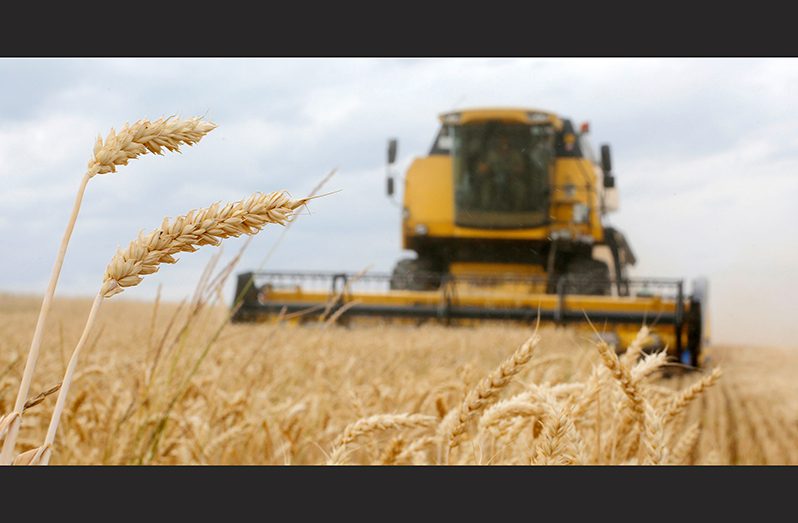THE barometer for world food commodity prices declined slightly in June for the third consecutive month, the Food and Agriculture Organization of the United Nations (FAO) reported on Friday.
The FAO Food Price Index averaged 154.2 points in June 2022, down 2.3 per cent from May. The Index, which tracks monthly changes in the international prices of a basket of commonly-traded food commodities, remained, however, 23.1 per cent higher than in June 2021.
The drop in June reflected declines in the international prices of vegetable oils, cereals and sugar, while dairy and meat prices increased.
The FAO Cereal Price Index averaged 166.3 points in June, down 4.1 per cent from May, but still 27.6 per cent above its June 2021 value. International wheat prices fell by 5.7 per cent in June but remained 48.5 per cent above their values a year ago.
The decline in June was driven by seasonal availability from new harvests in the northern hemisphere, improved crop conditions in some major producing countries, and higher production prospects in the Russian Federation.
International coarse grain prices also fell by 4.1 per cent but were still up 18.4 per cent from their year-earlier values. World maize prices fell by 3.5 per cent month-on-month due to increased seasonal availabilities in Argentina and Brazil and improved crop conditions in the United States of America.
The FAO Vegetable Oil Price Index averaged 211.8 points in June, down 7.6 per cent month-on-month. World palm oil prices declined on seasonally rising output of major producing countries and prospects of increasing supplies from Indonesia. Meanwhile, world sunflower and soy oil prices declined due to subdued global import demand in the wake of rising costs.
The FAO Sugar Price Index averaged 117.3 points in June, down 2.6 per cent from May, marking the second consecutive monthly decline and reaching its lowest level since February, influenced by good global availability prospects. Slowing global economic growth also weighed on international sugar demand and prices.
“Although the FAO Food Price Index dropped in June for the third consecutive month, it remained close to the all-time high of March this year. The factors that drove global prices high in the first place are still at play, especially a strong global demand, adverse weather in some major countries, high production and transportation costs, and supply chain disruptions due to COVID-19, compounded by the uncertainties stemming from the ongoing war in Ukraine,” said Máximo Torero Cullen, FAO Chief Economist.
Meanwhile, the FAO Meat Price Index averaged 124.7 points in June, up 1.7 per cent from May, setting a new record high and exceeding by 12.7 per cent its June 2021 value. World prices across all meat types increased, with those of poultry meat rising sharply, reaching an all-time high, underpinned by the continued tight global supply conditions impacted by the war in Ukraine and the Avian Influenza outbreaks in the Northern Hemisphere.
The FAO Dairy Price Index averaged 149.8 points in June, up 4.1 per cent from May and 24.9 per cent above its June 2021 value. In June, international prices of all dairy products increased. Cheese prices rose the most, mainly underpinned by a surge in import demand for spot supplies amid market concerns over supply availabilities later in the year. World milk powder prices increased on strong import demand and persistent global supply tightness.
FAO RAISES ITS FORECAST FOR GLOBAL CEREAL PRODUCTION
FAO’s forecast for global cereal production in 2022 was raised by 7 million tonnes in July from the previous month and is now pegged at 2 792 million tonnes, according to the new Cereal Supply and Demand Brief, also released today. This is still 0.6 per cent short of the world output in 2021.
The month-on-month increase predominantly rests on a 6.4-million-tonne upward revision made to the coarse grain production forecast, with the world output seen reaching 1,501 million tonnes in 2022, only 0.5 per cent below the 2021 outturn.
The forecast for world cereal utilization in 2022/23 has also been lifted, up 9.2 million tonnes to 2 797 million tonnes, but is still 1.7 million tonnes (0.1 per cent) below the 2021/22 level, mostly reflecting expectations of lower feed use.
At 854 million tonnes, FAO’s forecast of world cereal stocks at the close of seasons in 2023 is up 7.6 million tonnes from the previous month but still points to a year-on-year contraction of 0.6 per cent (5.0 million tonnes). At this level, the global cereal stock-to-use ratio would fall from 30.7 per cent in 2021/22 to 29.8 per cent in 2022/23.
FAO’s latest forecast for world trade in cereals in 2022/23 stands at 468 million tonnes, up 4.8 million tonnes from last month but representing the lowest level in three seasons and a decrease of 11.4 million tonnes (2.4 per cent) from the 2021/22 volume.
Accounting for the bulk of the decline, trade in coarse grains is forecast to contract by 4.1 per cent (9.5 million tonnes) in 2022/23 (July/June) from the 2021/22 estimated level, largely driven by war-related losses of maize and barley exports from Ukraine.
CROP PROSPECTS AND FOOD SITUATION REPORT
FAO assesses that 46 countries, including 33 in Africa, 10 in Asia, two in Latin America and the Caribbean and one in Europe are in need of external assistance for food, according to the latest Crop Prospects and Food Situation Report, released today by FAO’s Global Information and Early Warning System (GIEWS).
This list now includes Ukraine, where the war has resulted in significant numbers of displaced persons, and Sri Lanka, which is experiencing a multidimensional crisis that has led to high prices and severe shortages of essential products.
The FAO’s forecast for aggregate cereal production of the group of Low-Income Food-Deficit Countries (LIFDCs) in 2022 is pegged at 187.8 million tonnes, a marginal increase compared to the five-year average and the previous year, the report said.



.jpg)








